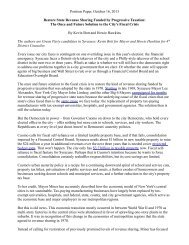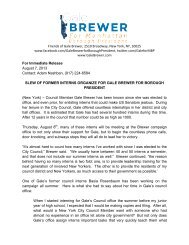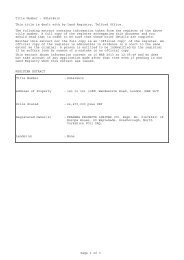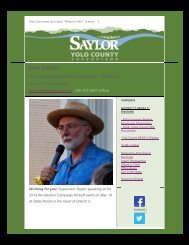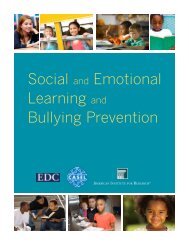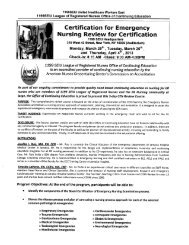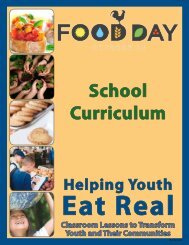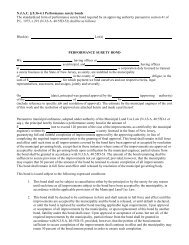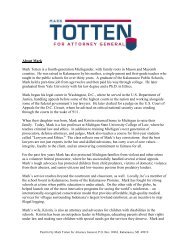You also want an ePaper? Increase the reach of your titles
YUMPU automatically turns print PDFs into web optimized ePapers that Google loves.
Lesson 5: Be an Advocate<br />
— Core Activity —<br />
Procedure<br />
1. Check in on Navigating the Environment Action Plans<br />
Have students share how they are doing with their Seeking Out Real <strong>Food</strong> Action Plans. Remind<br />
them that change is hard and takes time. Also, review the benefits of the <strong>Food</strong> <strong>Day</strong> Eating Goals for<br />
personal health and ecological sustainability. Also explain that as they navigate the environment,<br />
they are “voting” with their choices and paving the way to make whole, plant-based foods and small<br />
sizes of overly processed foods the norm, instead of the exception.<br />
Aim<br />
To plan a project that will<br />
change our community to<br />
make it easier for all to meet<br />
the <strong>Food</strong> <strong>Day</strong> Eating Goals.<br />
Materials<br />
• chart paper and markers<br />
• Advocacy Project Ideas<br />
lesson resource<br />
• <strong>Food</strong> Environment<br />
Advocacy Project activity<br />
sheet<br />
• Pledging to the <strong>Food</strong> <strong>Day</strong><br />
Eating Goals activity sheet<br />
Before You Begin<br />
• Discuss potential project<br />
sharing with other<br />
teachers from your school<br />
or community who are<br />
participating in the <strong>Food</strong><br />
<strong>Day</strong> lessons.<br />
2. Explain Becoming an Advocate for Change<br />
Ask students, “What if everyone started to seek out foods that meet the <strong>Food</strong> <strong>Day</strong> Eating Goals”<br />
Discuss that soon real, whole foods would be more available because the supply would meet the<br />
demand. And, in time, overly processed foods would become less available. This would also change<br />
the social norm. Explain that we can move this process along by doing a project that changes the<br />
food environment to make whole foods, and especially plant-based whole foods more readily available.<br />
If you would like to share some examples of types of projects use the Advocacy Project Ideas<br />
lesson resource.<br />
3. Brainstorm Ideas for Changing the <strong>Food</strong> Environment Projects<br />
Create a list of potential ideas that your class could do as a project that would change the environment<br />
to make foods that meet the <strong>Food</strong> <strong>Day</strong> goals more readily accessible to everyone in your home,<br />
school, community. Also consider a projects that would change the information environment to<br />
create promotions for whole foods, especially plant-based foods, or materials that educate people on<br />
the health and ecological consequences of eating too much overly processed foods.<br />
4. Choose One Project<br />
Review the list of projects. Choose one of the projects to work on by using these criteria to think<br />
about the projects: exciting to the class, would have a real impact on the food environment, and<br />
feasible given the resources and time you have to devote to the project. If other classes in your school<br />
are doing projects as well, you might want to team up with another class or plan a complementary<br />
project.<br />
5. Plan the Steps and Timeline for Your Project<br />
Distribute the <strong>Food</strong> Environment Advocacy Project activity sheet. As a first step to your plan, think<br />
through the goal of your project. The goal answers the question, “If our project is really successful,<br />
how will the food environment be better” A goal is important because this keeps you focused on<br />
what the project is all about and keeps you motivated to continue to work on the project even when<br />
you face obstacles. After you have a goal, create a list of the steps it will take to do your project, and<br />
create a timeline for completion of your project.<br />
6. Determine How to Evaluate the Effectiveness of Your Project<br />
Create a plan with your students for how you could determine if you are successful at meeting the<br />
goal for your project.<br />
7. Pledge to Continue to Follow the <strong>Food</strong> <strong>Day</strong> Eating Goals<br />
Distribute the Pledging to the <strong>Food</strong> <strong>Day</strong> Eating Goals activity sheet and have the students fill in what<br />
they will continue to do to “Eat Real,” “Mostly Plants,” “Not Too Much,” “Navigate the Environment,”<br />
and “Be an Advocate.” Have students review all their action plans as they complete this sheet.<br />
62 | <strong>Food</strong> <strong>Day</strong> Lessons



